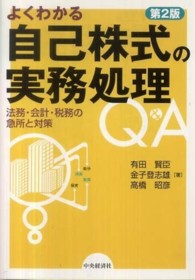- ホーム
- > 洋書
- > 英文書
- > Computer / General
Full Description
This book presents cybersecurity aspects of ubiquitous and growing IoT and Cyber Physical Systems. It also introduces a range of conceptual, theoretical, and foundational access control solutions. This was developed by the authors to provide an overall broader perspective and grounded approach to solve access control problems in IoT and CPS.
The authors discuss different architectures, frameworks, access control models, implementation scenarios, and a broad set of use-cases in different IoT and CPS domains. This provides readers an intuitive and easy to read set of chapters. The authors also discuss IoT and CPS access control solutions provided by key industry players including Amazon Web Services (AWS) and Google Cloud Platform (GCP). It provides extensions of the authors proposed fine grained solutions with these widely used cloud and edge supported platforms.
This book is designed to serve the computer science and the cybersecurity community including researchers,academicians and students. Practitioners who have a wider interest in IoT, CPS, privacy and security aspects will also find this book useful. Thanks to the holistic planning and thoughtful organization of this book, the readers are expected to gain in-depth knowledge of the state-of-the-art access control architectures and security models for resilient IoT and CPS.
Contents
1 Introduction: Requirements for Access Control in IoT and CPS.- 1.1 Introduction and Motivation.- 1.1.1 IoT Architectures.- 1.1.2 IoT and CPS Security Issues.- 1.2 Access Control Models.- 1.2.1 State of the Art.- 1.2.2 Access Control Models for Smart Connected Systems.- 1.3 Publish-Subscribe Paradigm.- 1.4 IoT and CPS Integration with Cloud and Edge Computing.- 1.5 Current Trends.- 1.6 Access Control Challenges and Research Needs.- 1.7 Summary.- References.- 2 Access Control Oriented Architectures Supporting IoT and CPS.- 2.1 Introduction.- 2.1.1 Chapter Organization.- 2.2 Primitives for Cloud and Edge Assisted Io.- 2.2.1 Taxonomy of Smart Devices.- 2.2.2 Cloud and Edge Hybrid Architectures.- 2.3 Access Control Oriented Architectures.- 2.3.1 Edge Gateway Supported ACO Architecture.- 2.3.2 Extended ACO Architecture with Clustered Objects.- 2.4 Illustrative IoT and CPS using Proposed Architectures.- 2.4.1 Remote Patient Monitoring (RPM).- 2.4.2 Intelligent Transportation System (ITS).- 2.5 Summary.- References.- 3 Authorization Frameworks for Smart and Connected Ecosystems 9.- 3.1 Introduction.- 3.1.1 Chapter Organization.- 3.2 Access Control Framework for Cloud Enabled Wearable IoT.- 3.2.1 Access Control Framework.- 3.2.2 RPM Wearable IoT Use Case.- 3.3 Framework for Smart Connected Cars Ecosystem.- 3.3.1 Access Control Framework.- 3.3.2 Identified Access Control Approaches.- 3.3.3 Single and Multi-Cloud Cyber Physical Systems.- 3.4 Objectives of Proposed Frameworks.- 3.5 Summary.- References.- 4 Access Control Models in Cloud IoT Services.- 4.1 Introduction.- 4.1.1 Chapter Organization 4.- 4.2 AWS Access Control Model5.- 4.3 Access Control in AWS Internet of Things: AWS-IoTAC.- 4.3.1 Motivation 8.- 4.3.2 Formal Model and Definitions.- 4.3.3 AWS-IoTAC and ACO Architecture.- 4.3.4 Use Case.- 4.4 Google Cloud Platform Access Control Model.- 4.4.1 GCP Access Control (GCPAC) Model.- 4.4.2 Access Control in GCP Internet of Things.-4.4.3 E-Health Use Case.- 4.5 Limitations and Fine Grained Enhancements.- 4.5.1 Proposed Enhancements in AWS IoTAC.- 4.5.2 Proposed Enhancements in GCP IoTAC.- 4.6 Summary.- References.- 5 Secure Virtual Objects Communication.- 5.1 Introduction.- 5.1.1 Chapter Organization.- 5.2 Operational Access Control for VO Communication.- 5.2.1 ACL and Capability Based (ACL-Cap) Operational Model.- 5.2.2 ABAC Operational Model.- 5.2.3 RBAC Limitations.- 5.3 Administrative Access Control for VO Communication.- 5.3.1 Administrative ACL Model.- 5.3.2 Administrative RBAC Model.- 5.3.3 Administrative ABAC Model.- 5.4 AWS-IoT-ACMVO Model for AWS IoT Shadows Communication.- 5.5 Issues in enforcing ACO-IoT-ACMsVO within AWS-IoT-ACMVO.- 5.6 A Use Case: Sensing Speeding Cars.- 5.6.1 Sensing the Speed of a Single Car.- 5.6.2 Sensing the Speed of Multiple Cars.- 5.6.3 Performance Evaluation and Discussion.- 5.7 Summary.- References.- 6 Attribute Based Access Control for Intelligent Transportation5.- 6.1 Introduction.- 6.1.1 Chapter Organization.- 6.2 Authorization Requirements in ITS.- 6.2.1 Multi-Layer and User Privacy Preferences.- 6.2.2 Relevance of Groups.- 6.3 Dynamic Groups and ABAC Model.- 6.3.1 CV-ABACG Model Overview.- 6.3.2 Components Definitions.- 6.4 AWS Enforcement.- 6.4.1 Use Case Overview.- 6.4.2 Prototype Implementation.- 6.4.3 Performance Evaluation.- 6.5 Summary.- References.- 7 Fine Grained Communication Control for IoT and CPS.- 7.1 Introduction.- 7.1.1 Motivation.- 7.1.2 Chapter Organization.- 7.2 Background and Related Work.- 7.2.1 CE-IoT Architectures.- 7.2.2 Related Work.- 7.2.3 Scope and Assumptions.- 7.3 Access Control and Communication Control Requirements.- 7.3.1 Use Case Scenarios.- 7.4 Attribute-Based Communication Control.- 7.4.1 Attribute-Based Access Control Model.- 7.4.2 Attribute-Based Communication Control Model.- 7.5 Attribute-Based Access and Communication Control Framework.- 7.5.1 ABAC-CC Framework.- 7.6 Summary.- References.








